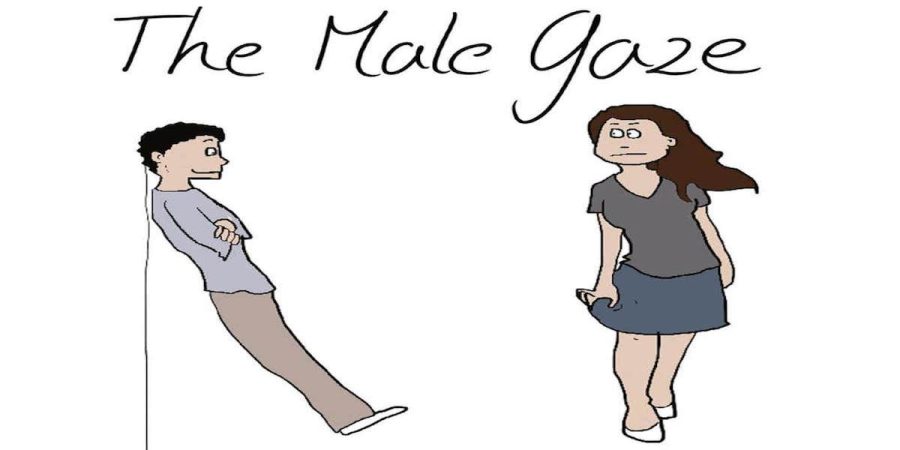The Male Gaze is a key idea in feminist theory and cultural analysis. Introduced by film theorist Laura Mulvey in 1975, it helps us understand how gender and power are shown in media, art, and culture. But what does the Male Gaze really mean, and why is it crucial to see its effects in our surroundings?
What is the Male Gaze?
The “Male Gaze” describes how visual arts, especially films, are made from a male viewpoint, often turning women into objects of male desire. In her influential essay, Visual Pleasure and Narrative Cinema, Laura Mulvey pointed out that mainstream films, particularly in the 20th century, were designed to favor the perspective of male viewers. In this context, women were usually shown in passive roles, with their looks and actions tailored to satisfy male fantasies.
Mulvey’s idea proposed that the camera lens itself carries a gender bias, supporting a patriarchal view where women are seen as objects to be observed, while men are the ones doing the observing. This concept of a “gaze” ÔÇö a specific way of seeing and understanding the world ÔÇö is what gives the theory its name.
Three Types of Gaze :
Mulvey’s research mainly looked at films, but the Male Gaze is a wider cultural idea that shapes how we view and value the world. Feminist scholars identify three main ways the Male Gaze operates:
- The Camera’s Gaze: In many movies, the camera takes on a male viewpoint. It often highlights women’s bodies, making them the center of male desire. For instance, close-ups of women or suggestive angles imply that the audience should admire the female form.
- The Characters’ Gaze: Male characters in films often look at women in objectifying ways. A man’s gaze can show power differences, with women depicted as passive and men as active.
- The Audience’s Gaze: The most important effect of the Male Gaze is how it shapes the audience’s view of women. Films, TV shows, ads, and books often guide viewers to see women in a way that supports the idea that they exist for male enjoyment.
Impact on Popular Media and Culture:
The Male Gaze isnÔÇÖt confined to the world of film. Its influence permeates nearly every form of media, from advertising to music videos, video games to magazines, and even social media platforms. For decades, women in popular culture have been portrayed in ways that center male desire and reinforce gendered expectations.
Consider the following examples:
- Hollywood Cinema: Many classic films from the “Golden Age” of Hollywood often centered around women whose main roles were to serve as romantic interests for male protagonists. Female characters, such as the iconic “Bond Girl,” were frequently defined by their beauty and their ability to attract or arouse the male lead.
- Advertising: Countless advertisements continue to objectify women to sell products. WomenÔÇÖs bodies are often used to sell everything from cars to perfumes, with the implicit suggestion that their beauty, appeal, or sexuality is central to the product’s worth.
- Music Videos: Many pop and hip-hop music videos feature highly sexualised depictions of women, often designed to appeal to a male gaze. The female dancers or models in these videos are frequently depicted as passive, decorative elements that exist solely for the pleasure of the male viewer.
- Video Games: Historically, video games have also been criticized for their portrayal of women. Female characters are often hyper-sexualized or relegated to secondary roles, existing to support or objectify male protagonists.
The male gaze, in this sense, doesn’t just affect how women are representedÔÇöit also shapes how we, as viewers, understand our own bodies, desires, and relationships to one another.
Examples of male gaze:
The Calvin Klein Ads (1990s)
In the 1990s, Calvin Klein created bold advertising campaigns that often sexualized women and young models, showing them in suggestive positions. These ads targeted mainly male viewers, highlighting women’s bodies in ways that emphasized their objectification. One of the most famous ads featured a young Brooke Shields in a provocative pose with the tagline, “You want to know what comes between me and my Calvins? Nothing.”
Why it stands out: These ads used the Male Gaze to market products, making women’s bodies the main focus. The strong sexualization aimed to attract male fantasies, presenting women as passive objects for male desire.
“Wonder Woman” (2017) ÔÇô Directed by Patty Jenkins
Wonder Woman, directed by Patty Jenkins, is a landmark film in many ways. Not only does it feature a female superhero at its core, but it also subverts many of the traditional gender roles and objectifying tropes seen in superhero films. Wonder Woman (Gal Gadot) is depicted as strong, intelligent, and capable, and the filmÔÇÖs visual style supports her autonomy rather than reducing her to an object of desire for the male gaze.
There are still moments in the film where the Male Gaze attempts to creep in, such as the scenes where Diana is depicted in her costume, which some critics argue could have been designed with less emphasis on her physical appearance. However, Diana’s agency and strength consistently overpower these moments, and the camera often focuses on her bravery, intelligence, and action rather than her body.
What makes it notable: While Wonder Woman occasionally falls into traditional gendered imagery, it also actively works to subvert the Male Gaze by presenting its lead character as a powerful, complex figure who is not there simply for male pleasure.

